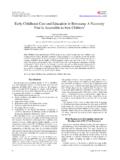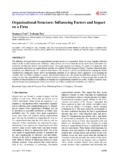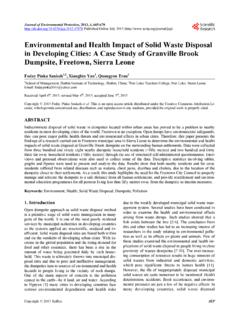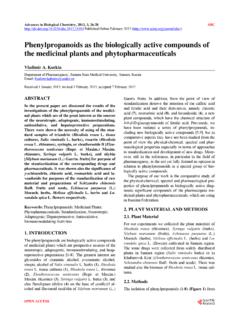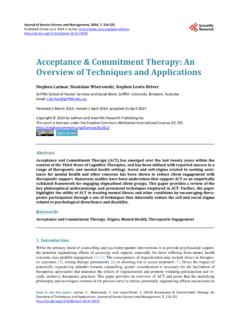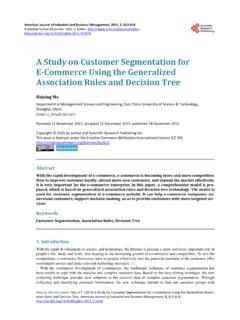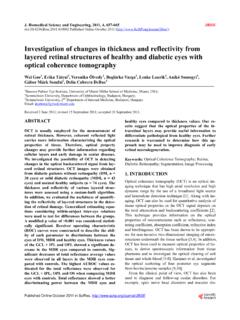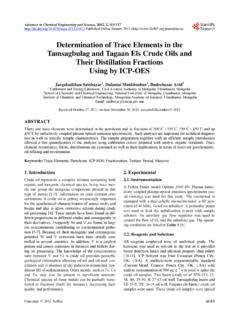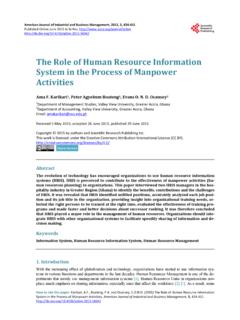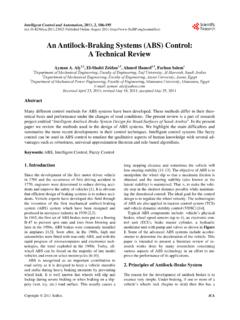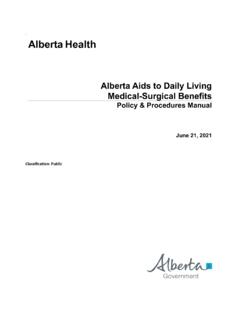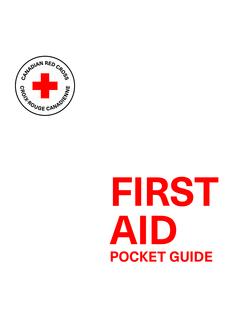Transcription of Therapeutic and Medicinal Uses of Aloe vera: A Review
1 Pharmacology & Pharmacy, 2013, 4, 599-610 599. Published Online November 2013 ( ). Therapeutic and Medicinal Uses of Aloe vera: A Review Pankaj K. Sahu1, Deen Dayal Giri2, Ritu Singh2, Priyanka Pandey1, Sharmistha Gupta3, Atul Kumar Shrivastava4, Ajay Kumar5, Kapil Dev Pandey5. 1. Department of Botany, Dr. Raman University, Bilaspur, India; 2 Department of Chemical Engineering & Technology, Institute of Technology, Banaras Hindu University, Varanasi, India; 3 West Bengal State Council of Science & Technology, Kolkata, India;. 4. Directorate of Research Services, JNKVV, Jabalpur, India; 5 Department of Botany, Banaras Hindu University, Varanasi, India. Email: Received September 3rd, 2013; revised October 8th, 2013; accepted October 17th, 2013. Copyright 2013 Pankaj K. Sahu et al. This is an open access article distributed under the Creative Commons Attribution License, which permits unrestricted use, distribution, and reproduction in any medium, provided the original work is properly cited.
2 ABSTRACT. The plant Aloe vera is used in Ayurvedic, Homoeopathic and Allopathic streams of medicine, and not only tribal com- munity but also most of the people for food and medicine. The plant leaves contains numerous vitamins, minerals, en- zymes, amino acids, natural sugars and other bioactive compounds with emollient, purgative, antimicrobial, anti in- flammatory, anti-oxidant, aphrodisiac, anti-helmenthic, antifungal, antiseptic and cosmetic values for health care. This plant has potential to cure sunburns, burns and minor cuts, and even skin cancer. The external use in cosmetic primarily acts as skin healer and prevents injury of epithelial tissues, cures acne and gives a youthful glow to skin, also acts as extremely powerful laxative. Keywords: Aloe vera; Antimicrobial; Therapeutic ; Medicinal Uses; Cosmetic Application 1. Introduction Synonym Plant extracts represent a continuous effort to find new Aloe barbadensis Miller, Aloe chinensis Bak.
3 , Aloe compound against pathogens. Approximately 20% of the elongata Murray, Aloe indica Royle, A. officinalis Forsk., plants found in the world have been submitted to phar- A. perfoliata L., A. rubescens DC, A. vera L. var. lit- macological or biological test, and a substantial number toralis K nig ex Bak., A. vera L. var. chinensis Berger, A. of new antibiotics introduced on the market are obtained vulgaris Lam. Most formularies and reference books from natural or semi synthetic resources [1]. The genus regard Aloe barbadensis Mill. as the correct species Aloe belonging to family Alliaceae is a succulent herb of name, and Aloe vera (L.) Burm. f. as a synonym. Ac- 80 - 100 cm in height which matures in 4 - 6 years and cording to International Rules of Botanical Nomenclature survives for nearly 50 years under favorable conditions. (IRBN), Aloe vera (L.) Burm. f. is the legitimate name Aloe vera (L.) Burm. f. syn. Aloe barbadensis Miller, is for this species [6].
4 Most biologically active among 400 species [2-4]. Ac- cording to World Health Organisation, Medicinal plants Taxonomic Treatment would be the best source for obtaining a variety of drugs This succulent perennial herb has triangular, sessile [5]. The plant is native to southern and eastern Africa stem, shallow root system, fleshy serrated leaves ar- along the upper Nile in the Sudan, and it was subse- ranged in rosette having 30 - 50 cm length and 10 cm quently introduced into northern Africa and naturalized breadth at the base; colour pea-green. The bright yellow in the Mediterranean region and other countries across tubular flowers, length 25 - 35 cm, axillary spike and the globe. The plant is commercially cultivated in Aruba, stamens are frequently projected beyond the perianth Bonaire, Haiti, India, South Africa, the United States of tube and fruits contain many seeds [7]. America, and Venezuela [6,7] while the finest quality of Aloe is grown in desert of Southern California.
5 The plant can survive in hot temperatures of 104 F and with stand 2. Active Ingredients in below freezing temperatures until root is not damaged. Leaves have three layers. The outer most layer consist of Open Access PP. 600 Therapeutic and Medicinal Use of Aloe vera: A Review 15 - 20 cells thick protective layer synthesizing carbohy- drates and proteins [8]. (Figure 1) The active compo- nents of aloe include anthraquinones, chromones, poly- saccharides, and enzymes. The anthraquinones and chro- mones are responsible for the anti-cancer activity, anti- inflammatory, and evacuating [9]. The elements Al, B, Ba, Ca, Fe, Mg, Na, P, Si etc. has also been reported to be present in Aloe vera gel [9-11]. Outer Protective Layers of Leaf The bitter yellow latex of pericyclic tubules in the outer layer of the leaves contain derivatives of hydroxyanthra- cene, anthraquinone and glycosides aloin A and B from Figure 1. The transverse section of the leaf exhibiting three 15% - 40% in different investigations [12-14].
6 The other cells layers, the protective layer, middle layer and colourless active principles of Aloe include hydroxyanthrone, aloe- inner layer. emodin-anthrone 10-C-glucoside and chrones. leaf [8]. The juice that is originated from cells of the pericycle and adjacent leaf parenchyma, flowing sponta- neously from the cut leaf get dried with or without the aid of heat and get solidified should not be confused with Aloe vera gel which is also the colourless mucilaginous gel that is obtained from the parenchymatous leaf cells [14]. The parenchymatous tissue or pulp shown to con- tain proteins, lipids, amino acids, vitamins, enzymes, inorganic compounds and small organic compounds in addition to the different carbohydrates. There is some evidence of chemotaxonomic variation in the polysac- charide composition [15-17] 16-different polysaccharides and 12 major polypeptides (mol wt 15 - 77 kD), and vari- ous glycoproteins (29 kD in leaf gel).
7 Inner Layers of Leaf The innermost layer of leaf gel contains water upto 99%, with glucomannans, amino acids, lipids, sterols and vi- tamins [8,17]. Structure of Aloin, Aloin A, Aloin B. Structure of Anthraquinone and structure of glycosides Middle Layer of Leaf The bitter yellow latex containing anthraquinones and The other potentially active ingredients include vita- glycosides has been reported from the middle layers of mins, enzymes, minerals, sugars, lignin, saponins, sali- Open Access PP. Therapeutic and Medicinal Use of Aloe vera: A Review 601. cylic acids, and amino acids [18-21]. It has numerous substrate [28]. Table 1 representing the chemical com- monosaccharide's and polysaccharides; vitamins B1, B2, position and properties and activity of Aloe vera. B6, and C; niacinamide and choline, several inorganic ingredients, enzymes (acid and alkaline phosphatase, 3. Therapeutic Use amylase, lactate dehydrogenase, lipase) and organic wound Healing compounds (aloin, barbaloin, and emodin) as described by [22].
8 The main functional component of Aloe vera is a wound healing is a dynamic process, occurring in 3. long chain of acetylated mannose [11,23,24]. Aloe gel is phases. The first phase is inflammation, hyperaemia and often commercialized as powdered concentrate. The leukocyte infiltration. The second phase consists of re- therapeutically, it is used to prevent progressive dermal moval of dead tissue. The third phase of proliferation ischemia due to burns, frostbite, electrical injury and consisting of epithelial regeneration and formation of intra arterial drug abuse. In vivo analysis of these injuries fibrous tissue [30]. demonstrates that this gel acts as an inhibitor of throm- A more recent Review concludes that the cumulative boxane A2, a mediator of progressive tissue damage [20]. evidence supports the use of Aloe vera for the healing of The Aloe vera gel play chief role in stimulation of the first to second degree burns [31]. The wound healing complement linked to polysaccharides, hydration, insula- property of Aloe vera gel has been attributed to Man- tion, and protection.
9 Application of fresh gel to normal nose-6-phosphate [25]. Actually, glucomannan and plant human cells in vitro promoted cell growth and attach- growth harmone gibberellins interacts with growth factor ment, whereas a stabilized gel preparation was cytotoxic receptors of fibrobroblast and stimulate its activity and to both normal and tumour cells. This cytotoxicity was proliferation for increases collagen synthesis in topical attributed to additional substances added to gel during and oral administration of Aloe according to Hayes [22]. processing [25]. The wound healing powers were due to The Aloe administration influence collagen composition a high molecular weighted polypeptide in healing of rat's (more type III) and increased collagen cross linking for excision wounds [26]. This glycoprotein promotes cell wound contraction and improving breaking strength [17]. proliferation, so gel improves wound healing by increas- It also increases synthesis of hyaluronic acid and derma- ing blood supply and increased oxygenation [4,27].
10 Tan sulfate in the granulation tissue of a healing wound Growth of new blood capillaries (angiogenesis) and tis- [32]. sue regeneration in the burn tissue for a guinea pig has Acemannan is considered the main functional compo- been reported, however, no specific constituents were nent of Aloe vera, is composed of a long chain of acety- identified [26]. Further, a low molecular weight com- lated mannose [11,23,24]. This complex carbohydrate pound from freeze-dried gel stimulated angiogenesis in accelerates wound healing and reduces radiation induced chick chorioallantoic membrane, and a methanol-soluble skin reactions [33,34]. Macrophage-activating potential fraction of the gel stimulated proliferation of arteries in acermannan may stimulate the release of fibrogenic cy- endothelial cells and induced them to invade a collage tokines [34,35]. Direct binding of acemannan to growth Table 1. Chemical composition and properties of Aloe vera [29].
